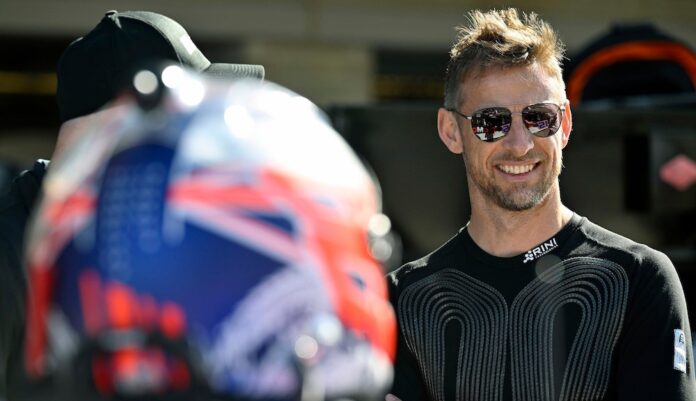Jenson Button will make his second NASCAR Cup Series start this weekend in Chicago, and he feels much more prepared than his first try over three months ago.
“I just had the seat fit and all looks good,” Button said. “I struggled with heat exhaustion during the (COTA) race, but now, I won’t have any issues. We’ve come up with a little solution that will make it a lot easier for me. In terms of the car and getting used to it, the first few laps, I will be finding my feet, having driven the car I did at Le Mans with traction control. It was a lot more compliant, a lot easier to drive.
“This is definitely a lot more edgy, so it’ll take me a few laps. But I think while everyone is learning the track, it’s not a bad thing at all. For me, it’s defining a setup that works, and a driveable setup gives you confidence. It’s what we’re aiming to do over the two simulator days before we actually get to the track, so we’re fully prepared.”
Button finished 24th in a debut at Circuit of the Americas that he described as an emotional roller coaster between dealing with the heat, adapting to a new ride, and the type of racing in the Cup Series.
Sunday will be the first time NASCAR has run a Cup Series race on a street course. Button ran 34 street course races during his Formula 1 career, and he expects Chicago to be no different regarding a tight and twisty circuit.
“It is what it is,” Button said. “You deal with it. When you look at IndyCar, which raced in Detroit, it was the tightest track that I’d ever seen. But it was a great race. So, I think we can put on a great show. I think that’s what this race is going to be about, really. It’s going to be a big learning curve for everyone. There’s no room for error.”
Button spent two days on the simulator last week to feel out the course. There is only so much the simulator can show, however. The focus for Button and his group was the car setup, which is another piece of the puzzle that has Button ready for another foray into the Cup Series.
“I think the big thing was how low they try to run the cars,” he said. “I’m used to massive downforce cars, and you have a range of where you put the rear of the car for the diffuser to work at its best. With the Cup car, the car basically has to be on the ground to get the diffuser to work properly, which takes away all your compliance and suspension. So, in high-speed corners, it was completely the opposite of what I thought a Cup car would be
“I thought it’d be very gradual, the slide, and it’d be easier to slide. But with this car, it’s the opposite. You get to a point where the rear just gives up, and the rear tire shutters – and you’re just fighting a lost cause, really. That was my biggest issue, and it meant that I couldn’t push the car as hard as I’d like because it was like a cliff – the feeling of grip, then no grip. So that’s something I know more now, but it’s something I want to work my way around and find a better direction.
“I still think there is a better option for a circuit like Chicago. The other one was just the racing. You can get used to a racing car, but you can’t get used to any car out there. It just takes time. The racing is something that takes longer – the style of racing, the aggression and the spotters. I was lucky enough to have some great spotters that were very helpful, but I didn’t realize how important they were going to be. So, having been through that once, going to Chicago, I’ll arrive a lot more confident.”



